Ultra-Deep Oil and Gas Geological Characteristics and Exploration Potential in the Sichuan Basin
Abstract
1. Introduction
2. Geological Background
2.1. Regional Setting and Stratigraphic Fill Patterns
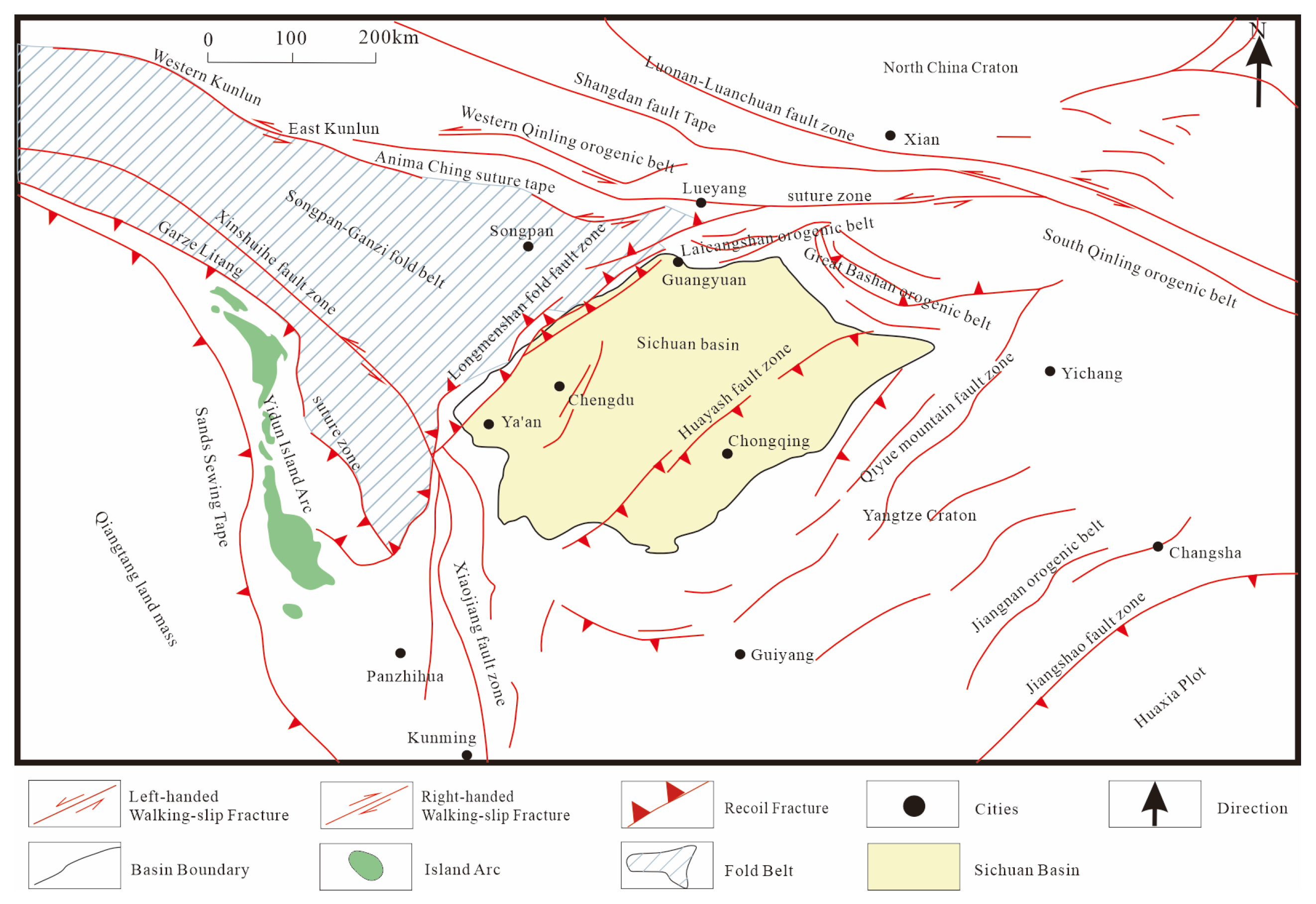
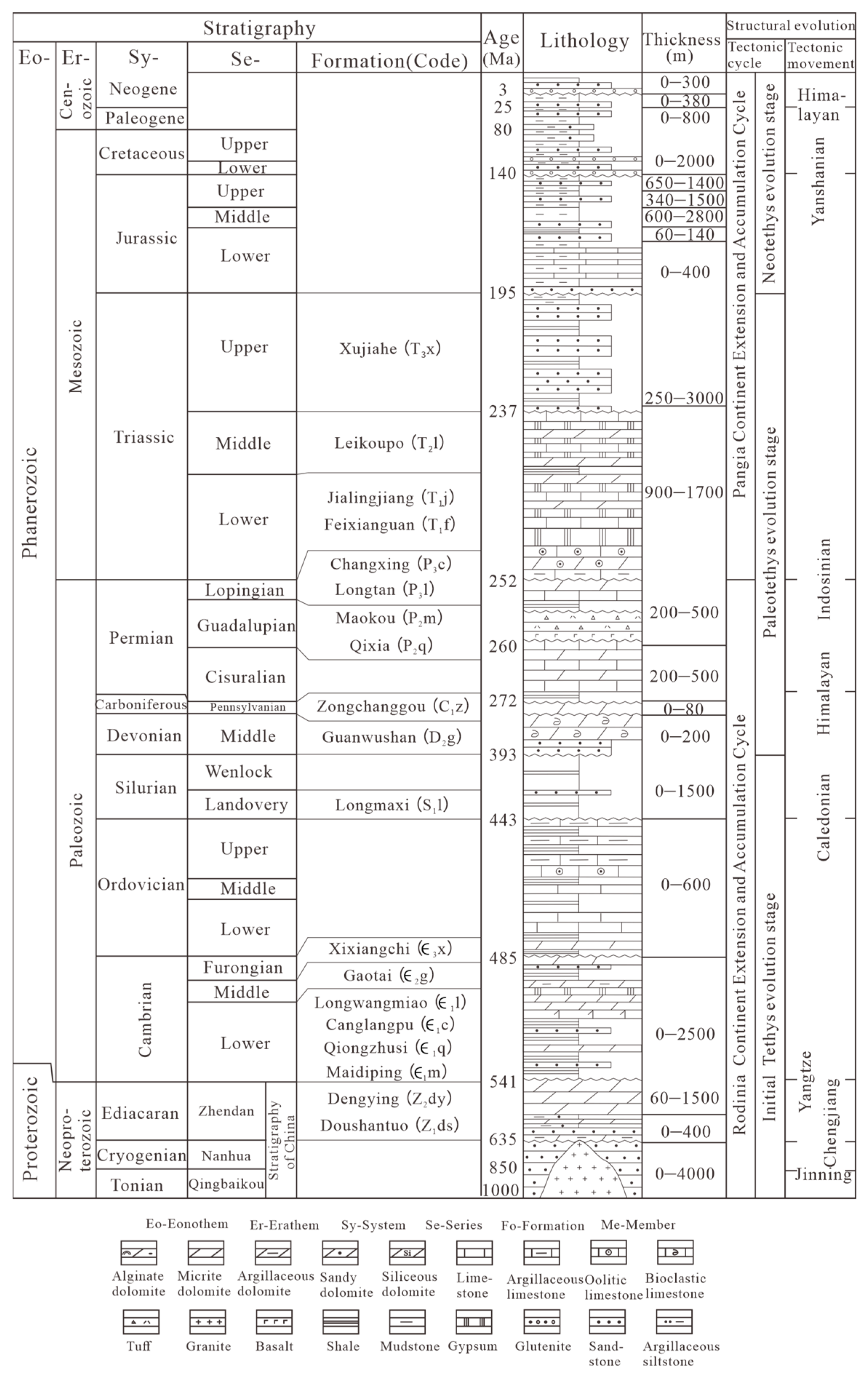
2.2. Tectonic Evolution and Stratigraphic Fill Characteristics of Ultra-Deep Strata
- Yangtze Cycle
- 2.
- Caledonian Cycle
- 3.
- Hercynian Cycle
3. Database and Methodology
3.1. Data Source
3.2. Deep and Ultra-Deep Oil and Gas Resource Potential
3.3. Development of Source Rocks in the Sichuan Basin
4. New Insights into Exploration in the Central–Northern Sichuan Basin
4.1. Widespread Distribution of Multi-Layered Ultra-Deep Source Rocks with Superior Hydrocarbon Generation Conditions
4.2. Large-Scale and Inherited Stacked Development of Multiple Sinian–Lower Paleozoic Mound–Shoal Complexes in Ultra-Deep Strata
4.3. Stable Geological Environment and Well-Developed Structural-Lithologic Traps in Northwestern Sichuan’s Ultra-Deep Strata Create Superior Accumulation Conditions
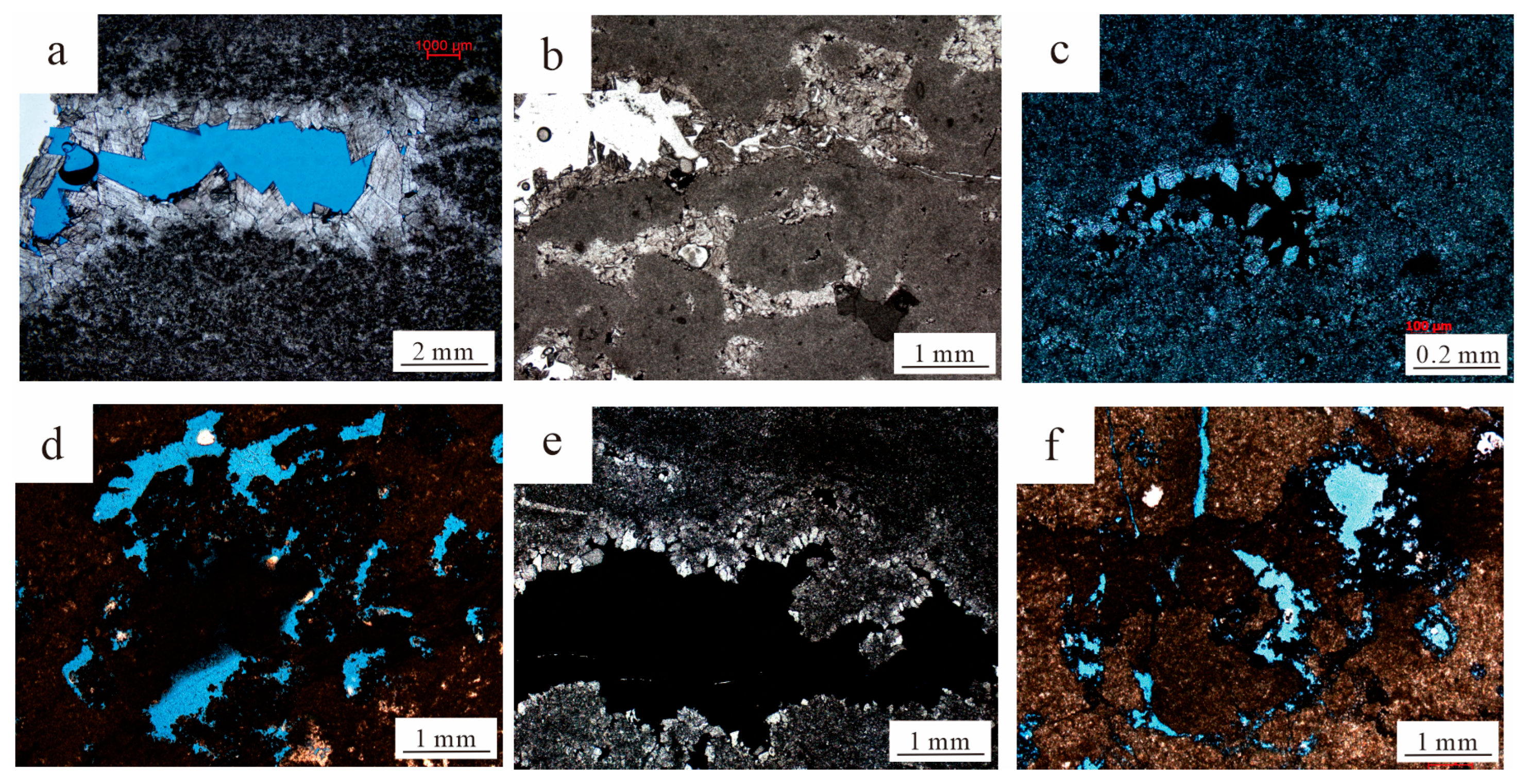
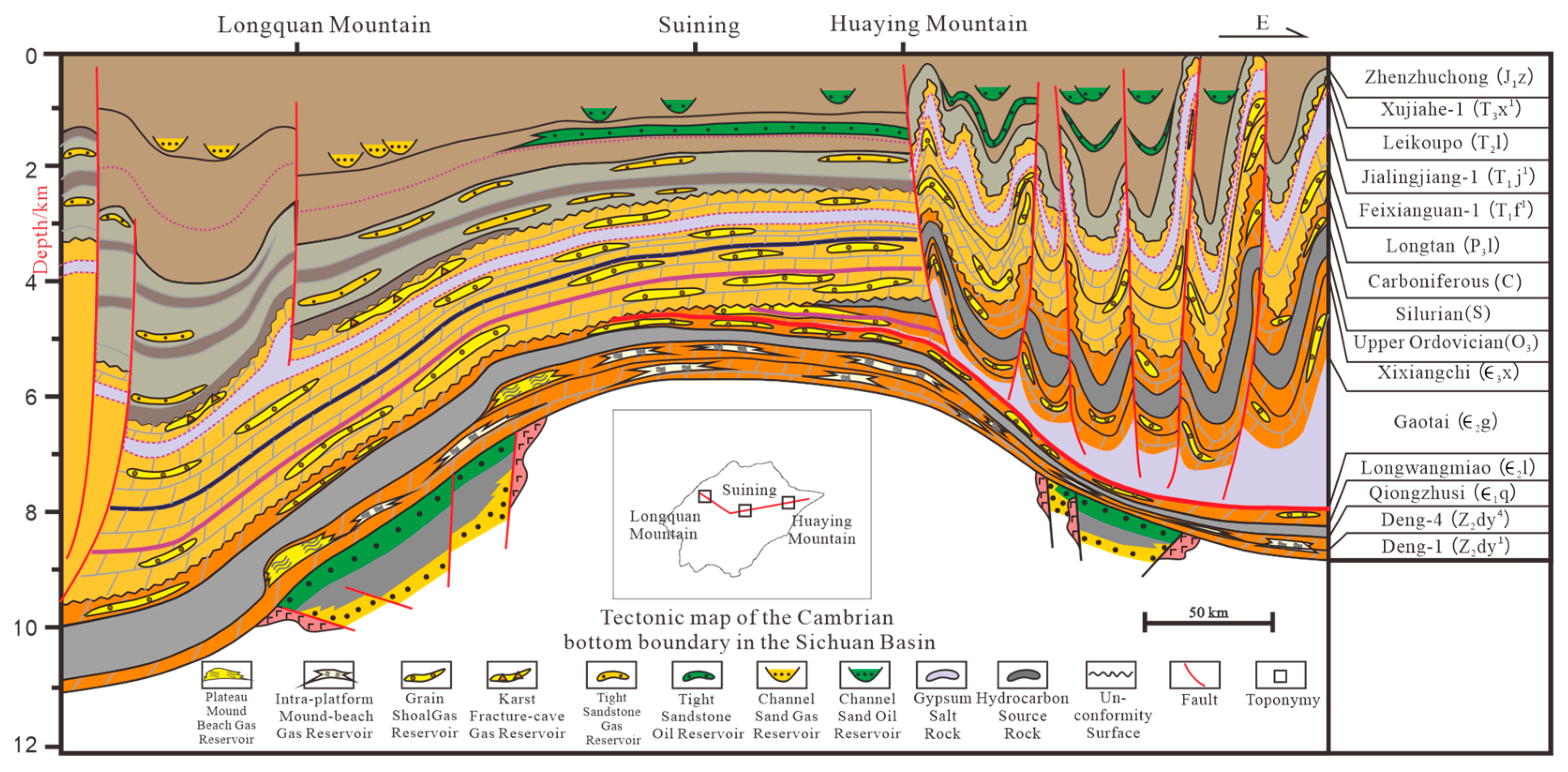
5. Analysis and Prospects of Ultra-Deep Natural Gas Exploration Potential in Sichuan Basin
6. Conclusions
Author Contributions
Funding
Data Availability Statement
Conflicts of Interest
References
- Huang, S.P.; Jiang, H.; Wang, T.S.; Wen, L.; Guan, S.W.; Zeng, F.Y.; Zhu, G.Y.; Tian, X.W.; Zhang, T.Y. Accumulation conditions and favorable exploration zones for natural gas in 8000 meters marine ultra-deep strata in the Sichuan basin. Acta Geol. Sin. 2023, 97, 1544–1560. [Google Scholar] [CrossRef]
- Chen, Z.; Li, W.; Wang, L.; Lei, Y.; Yang, G.; Zhang, B.; Yin, H.; Yuan, B. Structural geology and favorable exploration prospect belts in northwestern Sichuan Basin, SW China. Pet. Explor. Dev. 2019, 46, 413–425. (In Chinese) [Google Scholar] [CrossRef]
- Yu, H.; Juan, H.; Wen, Z. Distribution features and exploration potential of oil and gas in a deepwater area of the Gulf of Mexico Basin. Pet. Geol. Exp. 2015, 37, 473–478. [Google Scholar] [CrossRef]
- Zou, C.; Zhai, G.; Zhang, G.; Wang, H.; Zhang, G.; Li, J.; Wang, Z.; Wen, Z.; Ma, F.; Liang, Y.; et al. Formation, distribution, potential and prediction of global conventional and unconventional hydrocarbon resources. Pet. Explor. Dev. 2015, 42, 14–28. (In Chinese) [Google Scholar] [CrossRef]
- He, D.; Jia, C.; Zhao, W.; Xu, F.; Luo, X.; Liu, W.; Tang, Y.; Gao, S.; Zheng, X.; Li, D.; et al. Research progress and key issues of ultra-deep oil and gas exploration in China. Pet. Explor. Dev. 2023, 50, 1162–1172. [Google Scholar] [CrossRef]
- Jia, C. Key scientific and technological problems of petroleum exploration and development in deep and ultra-deep formation. J. China Univ. Pet. 2023, 47, 1–12. [Google Scholar] [CrossRef]
- Jia, C.; Zhang, S. The formation of marine ultra-deep petroleum in China. Acta Geol. Sin. 2023, 97, 2775–2801. [Google Scholar] [CrossRef]
- Dai, J.; Ni, Y.; Qin, S.; Huang, S.; Peng, W.; Han, W. Geochemical characteristics of ultra-deep natural gas in the Sichuan Basin, SW China. Pet. Explor. Dev. 2018, 45, 619–628. [Google Scholar] [CrossRef]
- He, D.; Li, D.; Zhang, G.; Zhao, L.; Fan, C.; Lu, Q.; Wen, Z. The formation and evolution of multi cycle superimposed basins in Sichuan Province. Geol. Sci. 2011, 46, 589–606. [Google Scholar] [CrossRef]
- Duan, J.; Mei, Q.; Li, B.; Liang, Z. The tectonic sedimentary evolution process of the Early Cambrian in the Sichuan Basin. Earth Sci. 2019, 44, 738–755. [Google Scholar] [CrossRef]
- Ma, Y.; He, Z.; Zhao, P.; Zhu, H.; Han, J.; You, D.; Zhang, J. New progress in the formation mechanism of deep-ultra-deep carbonate reservoirs. Acta Pet. Sin. 2019, 40, 1415–1425. (In Chinese) [Google Scholar]
- Guo, X.; Hu, D.; Huang, R.; Wei, Z.; Duan, J.; Wei, X.; Fan, X.; Miao, Z. Deep and ultra-deep natural gas exploration in the Sichuan Basin: Progress and prospect. Nat. Gas Ind. 2020, 7, 419–432. [Google Scholar] [CrossRef]
- Ren, J. Composition, structure, evolution and dynamics of Chinese mainland. Acta Geol. Sin. 1994, Z2, 5–13. (In Chinese) [Google Scholar]
- Shi, S.; Wang, Y.; Chen, C.; Liu, J.; Peng, P. Influence of tectonic evolution processes on burial, thermal maturation and gas generation histories of the Wufeng-Longmaxi shale in the Sichuan Basin and adjacent areas. Int. J. Coal Geol. 2024, 295, 104642. [Google Scholar] [CrossRef]
- Wei, G.; Li, J.; She, Y.; Zhang, G.; Shao, L.; Yang, G.; Guan, H.; Yang, S.; Lin, J.; Wang, R. Distribution law of large gas fields in China and the next exploration direction. Nat. Gas Ind. 2018, 38, 12–25. [Google Scholar] [CrossRef]
- Zhang, Z.; Zhao, L.; Zhang, D.; Li, Q.; Chen, H.; Wen, L.; Zhang, B.; Zhou, G.; Zhong, Y.; Wenzheng, L. Diagenetic evolution and cementation mechanism in deep Carbonate reservoirs: A case study of Dengying Fm. 2 in Penglai, Sichuan Basin, China. Mar. Pet. Geol. 2024, 170, 107084. [Google Scholar] [CrossRef]
- Shi, S.; Yang, W.; Zhou, G.; Jiang, H.; Meng, H.; Wu, S.; Zhang, Y.; Lu, W.; Bai, Z. Impact of Tethyan domain evolution on the formation of petroleum systems in the Sichuan super basin, SW China. Pet. Explor. Dev. 2024, 51, 1183–1201. [Google Scholar] [CrossRef]
- Yang, W.; Wei, G.; Wu, S.; Xie, W.; Jin, H.; Zeng, F.; Hao, C.; Bai, Z.; Su, Y.; Li, R. Regional unconformities and their controls on hydrocarbon accumulation in Sichuan Basin, SW China. Pet. Explor. Dev. 2023, 50, 573–587. [Google Scholar] [CrossRef]
- Chen, H.; Wang, S.; Mansour, A.; Qin, Q.; Ahmed, M.S.; Cen, Y.; Liang, F.; He, Y.; Fan, Y.; Gentzis, T. Key Characteristics and Controlling Factors of the Gas Reservoir in the Fourth Member of the Ediacaran Dengying Formation in the Penglai Gas Field, Sichuan Basin. Minerals 2025, 15, 98. [Google Scholar] [CrossRef]
- Wang, Z.; Jiang, H.; Wang, T.; Lu, W.; Gu, Z.; Xu, A.; Yang, Y.; Xu, Z. Paleo-geomorphology formed during Tongwan tectonization in Sichuan Basin and its significance for hydrocarbon accumulation. Pet. Explor. Dev. 2014, 41, 338–345. [Google Scholar] [CrossRef]
- Li, H.K. Study on Geological Structure and Superimposed Characteristics of Sichuan Basin. Ph.D. Thesis, Chengdu University of Technology, Chengdu, China, 2020. [Google Scholar] [CrossRef]
- Ma, K.; Wen, L.; Zhang, B.; Li, Y.; Zhong, J.; Wang, Y.; Peng, H.; Zhang, X.; Yan, W.; Ding, Y.; et al. Segmented evolution of Deyang-Anyue erosion rift trough in Sichuan Basin and its significance for oil and gas exploration, SW China. Pet. Explor. Dev. 2022, 49, 274–284. [Google Scholar] [CrossRef]
- Luo, B.; Yang, Y.; Luo, W.; Wen, L.; Wang, W.; Chen, K. Controlling factors of Dengying Formation reservoirs in the central Sichuan paleo-uplift. Pet. Res. 2017, 2, 54–63. [Google Scholar] [CrossRef]
- Yu, Y.; Long, W.; Gang, Z.; Weiyun, Z.; Haitao, L.; Zezhang, S.; Jing, Z.; Jiali, T.; Xingwang, T.; Jiutao, Y.; et al. New fields, new types and resource potentials of hydrocarbon exploration in Sichuan Basin. Acta Pet. Sin. 2023, 44, 2045–2069. [Google Scholar] [CrossRef]
- Liu, S.; Yang, Y.; Deng, B.; Zhong, Y.; Wen, L.; Sun, W.; Li, Z.; Jansa, L.; Li, J.; Song, J.; et al. Tectonic evolution of the Sichuan Basin, Southwest China. Earth-Sci. Rev. 2021, 213, 103470. [Google Scholar] [CrossRef]
- Xie, W.; Wen, L.; Wang, Z.; Hao, Y.; Xin, Y.; Wu, S.; Li, W.; Yao, Q.; Ma, S.; Chen, Y. Permian-Middle Triassic marine unconventional resource types and favorable exploration directions in Sichuan Basin. Nat. Gas Geosci. 2024, 35, 961–971. [Google Scholar] [CrossRef]
- Deng, K.L. Formation and Evolution of Sichuan Basin and Domains for Oil and Gas Exploration. Nat. Gas Ind. 1992, 12, 7–12. (In Chinese) [Google Scholar]
- Huang, F.; Wang, S.; Li, M.; Ouyang, J.; Liu, C.; Liu, H.; Zeng, F.; Fan, J.; Jia, P. Progress and implications of deep and ultra-deep oil and gas exploration in PetroChina. Nat. Gas Ind. 2024, 44, 86–96. [Google Scholar] [CrossRef]
- Hu, Y.; Peng, X.; Li, Q.; Li, L.; Hu, D. Progress and development direction of technologies for deep marine carbonate gas reservoirs in the Sichuan Basin. Nat. Gas Ind. B 2020, 7, 149–159. [Google Scholar] [CrossRef]
- Zheng, H.; Ma, Y.; Chi, G.; Qing, H.; Liu, B.; Zhang, X.; Shen, Y.; Liu, J.; Wang, Y. Stratigraphic and Structural Control on Hydrothermal Dolomitization in the Middle Permian Carbonates, Southwestern Sichuan Basin (China). Minerals 2019, 9, 32. [Google Scholar] [CrossRef]
- Qiao, Z.; Yu, Z.; She, M.; Pan, L.; Zhang, T.; Li, W.; Shen, A. New progress in the genesis of ancient ultra-deep marine carbonate reservoirs in China. Acta Paleogeogr. 2023, 25, 1257–1276. [Google Scholar] [CrossRef]
- Zhu, G.; Jiang, H.; Huang, S.; Ma, D.; Zhang, M.; Chen, W.; Guan, S.; Fan, J.; Zeng, F. New Progress in China’s Marine Oil and Gas Accumulation Theory and Prediction of 10,000-meter-deep Super-large Oil and Gas Areas. Acta Pet. Sin. 2025, 46, 816–842. [Google Scholar] [CrossRef]
- Wang, Z.; Zhao, Z.; Huang, F.; Shi, Y.; Xu, Y.; Zhang, S. Ultra-deep hydrocarbon accumulation conditions and exploration potential in sedimentary basins of Central-Western China. World Pet. Ind. 2024, 31, 33–48. [Google Scholar] [CrossRef]
- Tenger; Liu, W.; Qin, J.; Zheng, L.; Fu, X.; Shen, B.; Lu, L.; Wang, J. Dynamic transformation mechanism for hydrocarbon generation from multiple sources in deep-buried marine carbonates in the northeastern Sichuan Basin: A case study from the Puguang gas field. Acta Petrol. Sin. 2012, 28, 895–904. [Google Scholar]
- Du, J.; Wang, Z.; Zou, C.; Xu, C.; Shen, P.; Zhang, B.; Jiang, H.; Huang, S. Discovery of intrrcratonie rift in the Upper Yangtze and its coutrol effect on the formation of Anyue giant gas field. Russ. Geol. Geophys. 2020, 61, 478–494. [Google Scholar] [CrossRef]
- Li, J.; Tao, X.; Bai, B.; Huang, S.; Jiang, Q.; Zhao, Z.; Chen, Y.; Ma, D.; Zhang, L.; Li, N.; et al. Geological conditions, reservoir evolution and favorable exploration directions of marine ul-tra-deep oil and gas in China. Pet. Explor. Dev. 2021, 48, 52–79. [Google Scholar] [CrossRef]
- Ma, X. Exploration of the Enrichment Law and Scale Effective Development of Shale Gas in the Southern Sichuan Basin. Nat. Gas Ind. 2018, 38, 240–249. [Google Scholar] [CrossRef]
- Liang, X.Q.; Zhou, Y.; Jiang, Y.; Wen, S.N.; Fu, J.G.; Wang, C. Difference of sedimentary response to Dongwu Movement: Study on LA-ICPMS U-Pb ages of detrital zircons from Upper Permian Wujiaping or Longtan Formation from the Yangtze and Cathaysia blocks. Acta Petrol. Sin. 2013, 29, 3592–3606. [Google Scholar]
- Chen, J.; Li, W.; Ni, Y.; Liang, D.; Deng, C.; Bian, L. Permian source rocks and their natural gas exploration potential in Sichuan Basin (1) Spatial distribution characteristics of source rocks. Nat. Gas Ind. 2018, 38, 1–16. [Google Scholar] [CrossRef]
- Xu, M.; Zhu, C.Q.; Tian, Y.T.; Rao, S.; Hu, S.B. Borehole temperature logging and characteristics of subsurface temperature in Sichuan Basin. Chin. J. Geophys. 2011, 54, 1052–1060. (In Chinese) [Google Scholar] [CrossRef]
- Yang, Y.; Yang, Y.; Yang, G.; Song, J.; Wen, L.; Deng, C.; Xia, M.; Ran, Q.; Duan, G.; Luo, B.; et al. Gas accumulation conditions and key technologies for exploration & development of Sinian and Cambrian gas reservoirs in Anyue gasfield. Pet. Res. 2018, 3, 221–238. [Google Scholar] [CrossRef]
- Ma, X.; Yang, Y.; Wen, L.; Luo, B. Distribution and exploration direction of medium- and large-sized marine carbonate gas fields in Sichuan Basin, SW China. Pet. Explor. Dev. 2019, 46, 1–13. (In Chinese) [Google Scholar] [CrossRef]
- Jin, M.; Zeng, W.; Tan, X.; Li, L.; Li, Z.; Luo, B.; Zhang, J.; Liu, J. Characteristics and controlling factors of beach-controlled karst reservoirs in Cambrian Longwangmiao Formation, Moxi-Gaoshiti area, Sichuan Basin, NW China. Pet. Explor. Dev. 2014, 41, 712–723. [Google Scholar] [CrossRef]
- Jiang, Y.; Gu, Y.; Zhu, X.; Xu, W.; Xiao, Y.; Li, J. Hydrothermal dolomite reservoir facies in the Sinian Dengying Fm, central Sichuan Basin. Nat. Gas Ind. B 2017, 4, 287–293. [Google Scholar] [CrossRef]
- Wei, G.; Yang, W.; Du, J.; Xu, C.; Zou, C.; Xie, W.; Wu, S.; Zeng, F. Tectonic features of Gaoshiti-Moxi paleo-uplift and its controls on the formation of a giant gas field, Sichuan Basin, SW China. Pet. Explor. Dev. 2015, 42, 283–292. [Google Scholar] [CrossRef]
- Xiao, D.; Wen, L.; Zhang, Y.; Xie, C.; Tan, X.; Cao, J. Natural gas accumulation in the basin–mountain transition zone, northwestern Sichuan Basin, China. Mar. Pet. Geol. 2021, 133, 105305. [Google Scholar] [CrossRef]
- Xiao, D.; Cao, J.; Luo, B.; Zhang, Y.; Xie, C.; Chen, S.; Gao, G.; Tan, X. Mechanism of ultra-deep gas accumulation at thrust fronts in the Longmenshan Mountains, lower Permian Sichuan Basin, China. J. Nat. Gas Sci. Eng. 2020, 83, 103533. [Google Scholar] [CrossRef]
- Zheng, C.; Zhang, B.; Li, R.; Yin, H.; Wang, Y.; Hu, X.; Chen, X.; Liu, R.; Zeng, Q.; Sun, Z.; et al. Facies-controlled prediction of dolomite reservoirs in the Middle Permian Qixia Formation in Shuangyushi, northwestern Sichuan Basin. Energy Geosci. 2024, 5, 100230. [Google Scholar] [CrossRef]
- Yang, Y.; Jiang, P.; Zhang, B.; Di, X.; Hua, W.; Cheng, L.; Ya, Z.; Xiao, C.; Ran, L.; Ya, L. Formation of ultra-deep integrated giant gas field in Qixia Formation of Shuangyushi structure in the foothill complex structural belt of Longmen mountain. Nat. Gas Ind. 2022, 42, 1–11. [Google Scholar] [CrossRef]
- Wei, G.; Xie, Z.; Yang, Y.; Li, J.; Yang, W.; Zhao, L.; Yang, C.; Zhang, L.; Xie, W.; Jiang, H.; et al. Formation conditions of Sinian–Cambrian large lithologic gas reservoirs in the north slope area of central Sichuan Basin, SW China. Pet. Explor. Dev. 2022, 49, 963–976. [Google Scholar] [CrossRef]
- Xie, W.; Chen, S.; Gan, H.; Wang, H.; Wang, M.; Vandeginste, V. Preservation conditions and potential evaluation of the Longmaxi shale gas reservoir in the Changning area, southern Sichuan Basin. Geosci. Lett. 2023, 10, 36. [Google Scholar] [CrossRef]
- Zhou, G.; Tian, X.; Wen, L.; Zhang, B.; Yang, D.; Yao, J.; Sun, Y.; Xiang, Z.; Zhou, L.; Tang, H. New evidence of Devonian-Carboniferous paleo-depression in the western Sichuan Basin and its implications for oil and gas geology. Nat. Gas Ind. 2023, 43, 1–11. [Google Scholar] [CrossRef]


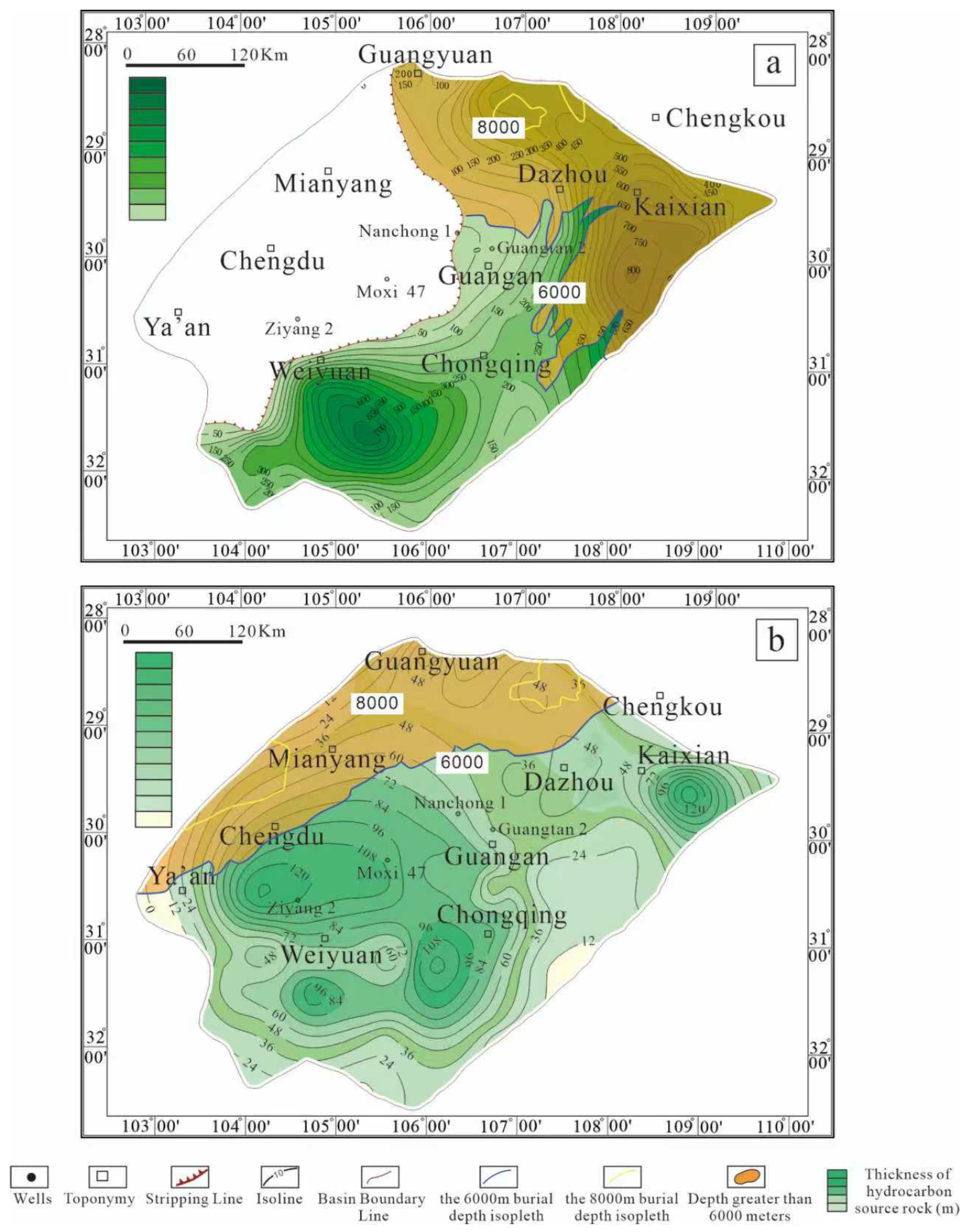
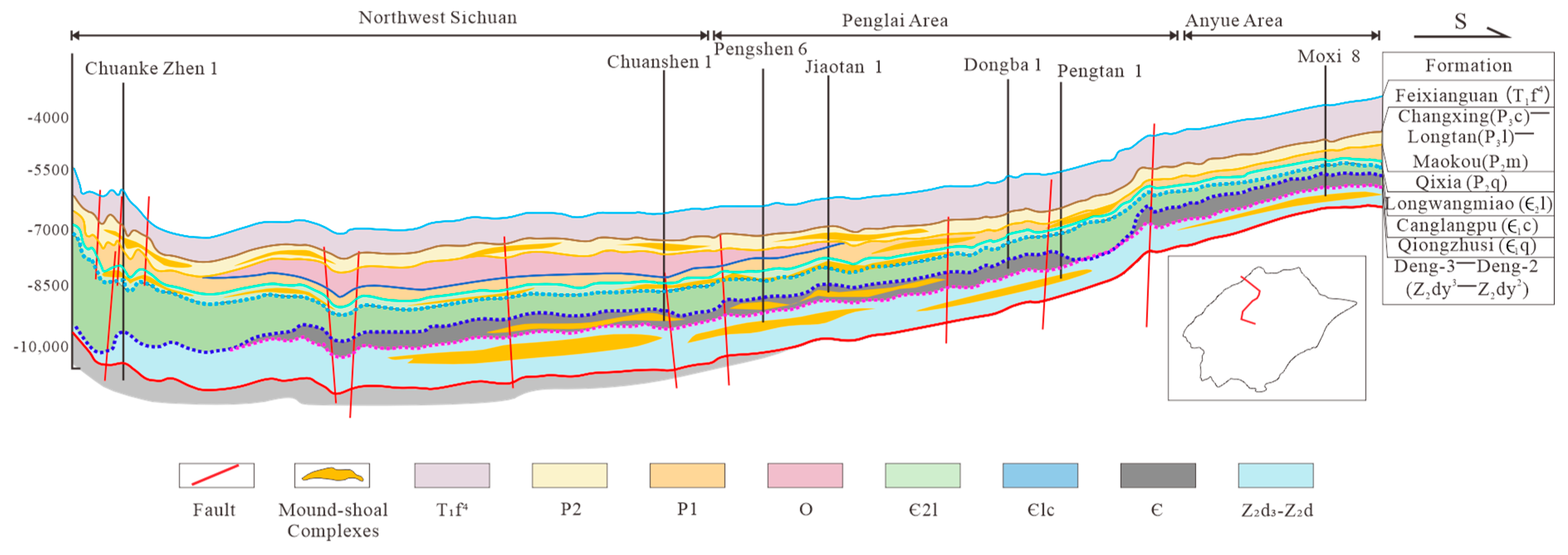
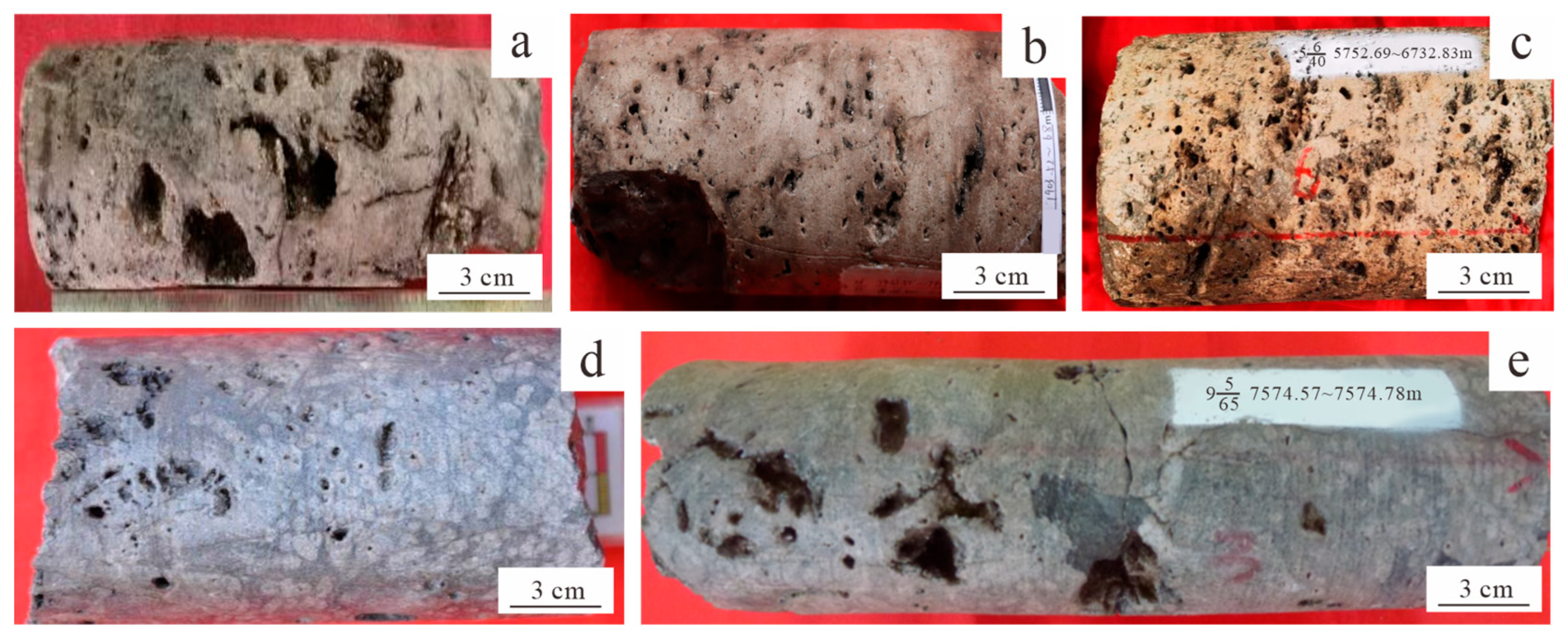

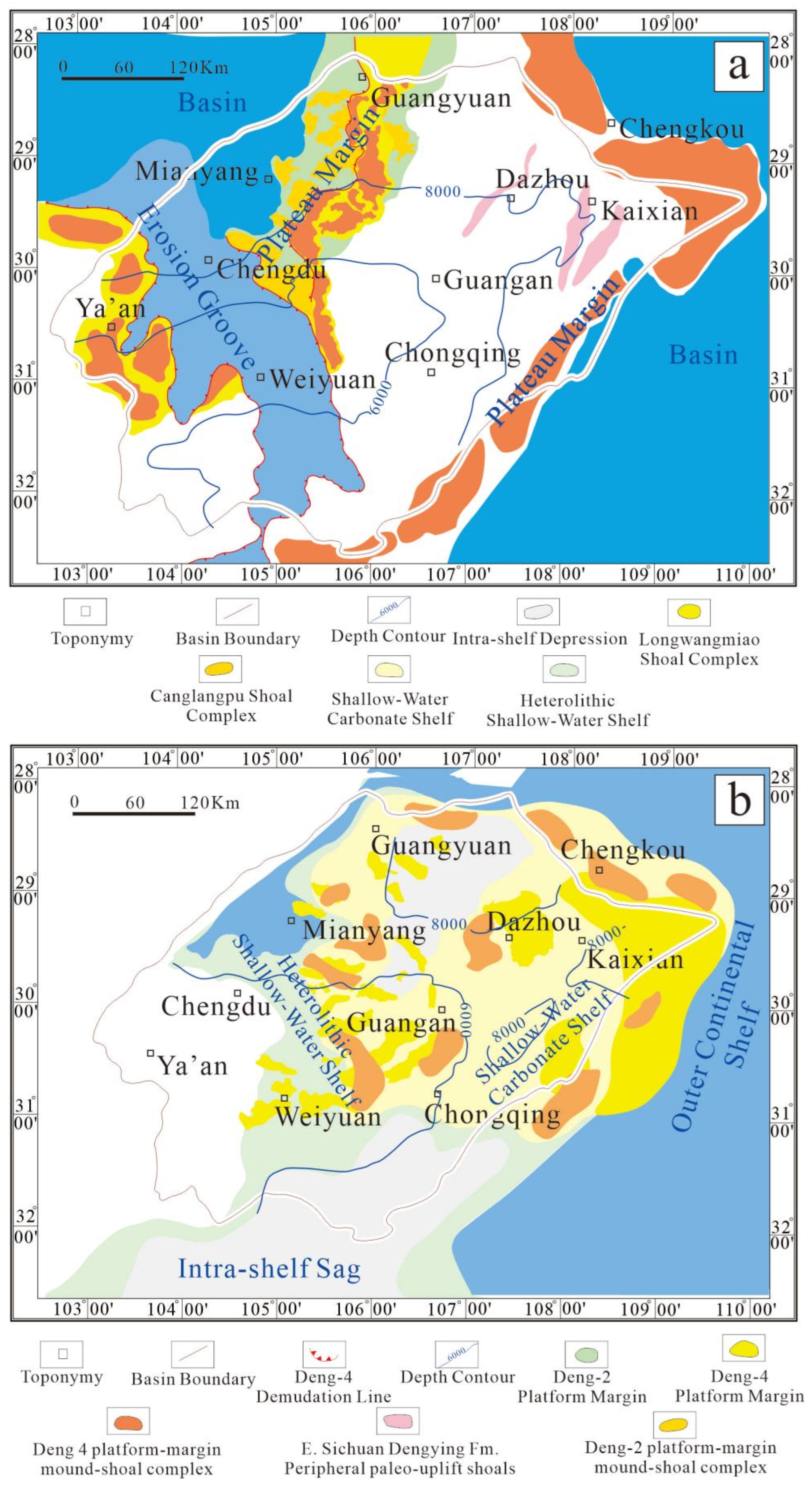

| Serial Number | The Field of Oil and Gas Exploration | Basin | Prospective Block | Favorable Area | Remaining Resources Estimation for the Block | Block Ranking | |
|---|---|---|---|---|---|---|---|
| Oil/108 t | Gas/1012 m3 | ||||||
| 1 | Marine Carbonate Rocks | Sichuan Basin | Slope belt of the paleo-uplift in the northwestern Sichuan Basin | 0.8 | 2.5 | 1 | |
| 2 | Permian Platform Margin Belt in Sichuan Basin | 0.2 | 2 | 3 | |||
| 3 | Synclinal Area in the Eastern-Southern Sichuan Basin | 2.2 | 0.5 | 4 | |||
| 4 | Reef-Bank Complex in the Northern Rift Depression of the Sichuan Basin | 0.1 | 0.2 | 7 | |||
| 5 | Tarim Basin | Manxi Diliang Fault Zone in the Fuman Area | 0.7 | 5.2 | 5 | ||
| 6 | Fault-Controlled Cambrian Platform Margin Belt in the Lunnan Area | 0.3 | 0.6 | 8 | |||
| 7 | Fault-Controlled Ordovician Platform Margin Belt in the Gucheng Area | 0.1 | 0.3 | 10 | |||
| 10 | Foreland Thrust Belt | Tarim Basin | Kuche Foreland Thrust Belt | 1.1 | 7.2 | 2.8 | 2 |
| 11 | Junggar Basin | Deep Structural Assemblage in the Southern Junggar Basin | 1.3 | 2.1 | 6 | ||
| 12 | Deep Shale Gas | Sichuan Basin | Silurian Strata in Southern Sichuan Basin | 0.7 | 8.7 | 9 | |
| Region | Strata | Buried Depth Range (m) | Reservoir Thickness (m) | Type of Trap | Distribution Area (km2) | Favorable Area (km2) | Resource Potential (1012 m3) |
|---|---|---|---|---|---|---|---|
| Eastern Sichuan | Dengying Formation | 6000–8000 | 10–100 | tectonic | 22,800 | 4000 | 0.3 |
| >8000 | 10–100 | tectonic | 21,800 | 6000 | 0.9 | ||
| Cambrian Longwangmiao Formation | 6000–8000 | 10–60 | / | 18,000 | 4500 | 0.4 | |
| >8000 | 10–40 | / | 16,000 | 2000 | 0.2 | ||
| Cambrian Canglangpu Formations | 6000–8000 | 8–50 | Lithology | 19,000 | 4200 | 0.5 | |
| >8000 | 8–40 | Lithology | 12,000 | 1200 | 0.2 | ||
| Carboniferous Huanglong Formation | 6000–8000 | 10–30 | Tectonic–stratigraphy | 15,000 | 2000 | 0.5 | |
| >8000 | 10–30 | Tectonic–stratigraphy | 2000 | 500 | 0.5 | ||
| Western Sichuan–Northern Sichuan | Sinian Dengying Formation | 6000–8000 | Deng-4: 50–170 Deng-2: 50–350 | Lithology | 11,500 | 4900 | 3.3 |
| >8000 | Deng-4: 70–200 Deng-2: 50–400 | Tectonic–lithology | 25,700 | 7700 | 4.9 | ||
| Cambrian Longwangmiao Formation | 6000–8000 | 10–60 | Lithology | 16,200 | 2500 | 0.3 | |
| >8000 | 10–40 | Lithology | 10,000 | 1100 | 0.1 | ||
| Cambrian Canglangpu Formations | 6000–8000 | 10–60 | Lithology | 16,000 | 4300 | 1.1 | |
| >8000 | 10–50 | Lithology | 4000 | 1000 | 0.4 | ||
| Devonian–Carboniferous Guanwushan and Zongchanggou Formation | 6000–8000 | 10–20 | Tectonic–stratigraphy | 6500 | 2500 | 1 | |
| >8000 | 10–20 | Tectonic–stratigraphy | 5500 | 2000 | 1 | ||
| Permian Qixia Formations | 6000–8000 | 18–45 | Tectonic–lithology | / | 3500 (Enclosure area) | 0.4 | |
| Permian Maokou Formation | 6000–8000 | Maokou-2 period: 10–35 | Tectonic–lithology | / | 5400 (Enclosure area) | 0.8 | |
| Permian Changxing and Feixianguan Formations | >6000 | Changxing Formation: 10–100 Feixianguan Formation: 10–30 | Tectonic–lithology | / | 2700 (Enclosure area) | 0.7 |
| Region | Strata | Average Total Organic Carbon Content | Thickness (m) |
|---|---|---|---|
| Eastern Sichuan | Longmaxi | >2% | 200–600 |
| Qiongzhusi | 1.5% | 50–200 | |
| Doushantuo | 4.76% | 20–100 | |
| Western Sichuan–Northern Sichuan | Longmaxi | >2% | 0–200 |
| Qiongzhusi | 1.87% | 300–700 | |
| Maidiping | 1.8% | 30–130 | |
| Doushantuo | 3.9% | 10–300 |
Disclaimer/Publisher’s Note: The statements, opinions and data contained in all publications are solely those of the individual author(s) and contributor(s) and not of MDPI and/or the editor(s). MDPI and/or the editor(s) disclaim responsibility for any injury to people or property resulting from any ideas, methods, instructions or products referred to in the content. |
© 2025 by the authors. Licensee MDPI, Basel, Switzerland. This article is an open access article distributed under the terms and conditions of the Creative Commons Attribution (CC BY) license (https://creativecommons.org/licenses/by/4.0/).
Share and Cite
Zhou, G.; Zhang, Z.; Yan, Z.; Li, Q.; Chen, H.; Du, B. Ultra-Deep Oil and Gas Geological Characteristics and Exploration Potential in the Sichuan Basin. Appl. Sci. 2025, 15, 11380. https://doi.org/10.3390/app152111380
Zhou G, Zhang Z, Yan Z, Li Q, Chen H, Du B. Ultra-Deep Oil and Gas Geological Characteristics and Exploration Potential in the Sichuan Basin. Applied Sciences. 2025; 15(21):11380. https://doi.org/10.3390/app152111380
Chicago/Turabian StyleZhou, Gang, Zili Zhang, Zehao Yan, Qi Li, Hehe Chen, and Bingjie Du. 2025. "Ultra-Deep Oil and Gas Geological Characteristics and Exploration Potential in the Sichuan Basin" Applied Sciences 15, no. 21: 11380. https://doi.org/10.3390/app152111380
APA StyleZhou, G., Zhang, Z., Yan, Z., Li, Q., Chen, H., & Du, B. (2025). Ultra-Deep Oil and Gas Geological Characteristics and Exploration Potential in the Sichuan Basin. Applied Sciences, 15(21), 11380. https://doi.org/10.3390/app152111380






